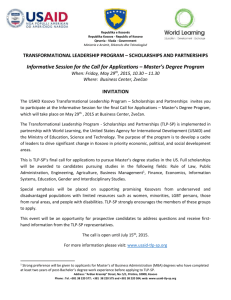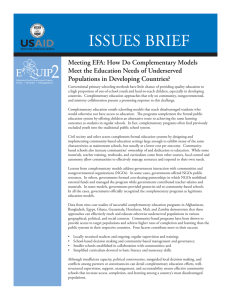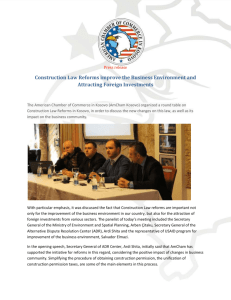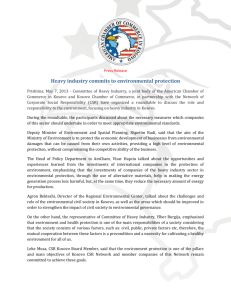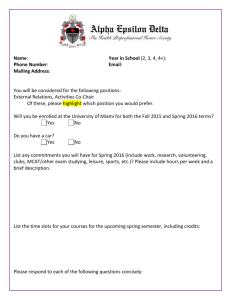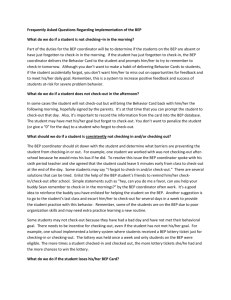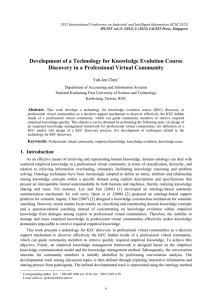1300111424-BEP_AED_USAID_giving_and_receiving_feedback
advertisement
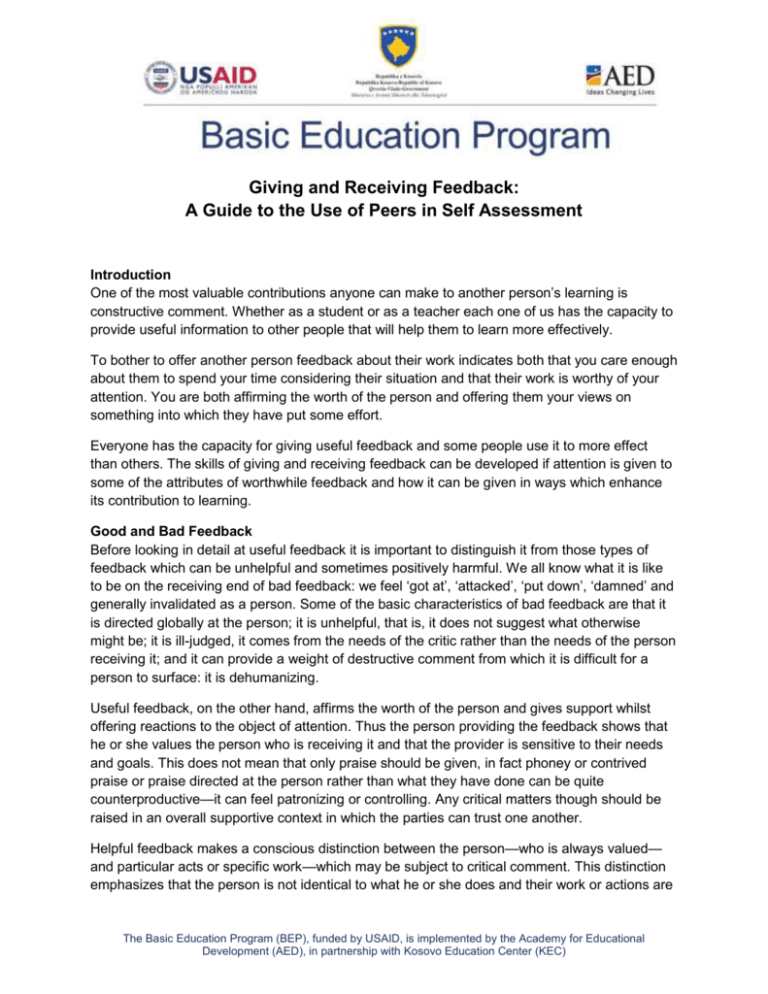
Giving and Receiving Feedback: A Guide to the Use of Peers in Self Assessment Introduction One of the most valuable contributions anyone can make to another person’s learning is constructive comment. Whether as a student or as a teacher each one of us has the capacity to provide useful information to other people that will help them to learn more effectively. To bother to offer another person feedback about their work indicates both that you care enough about them to spend your time considering their situation and that their work is worthy of your attention. You are both affirming the worth of the person and offering them your views on something into which they have put some effort. Everyone has the capacity for giving useful feedback and some people use it to more effect than others. The skills of giving and receiving feedback can be developed if attention is given to some of the attributes of worthwhile feedback and how it can be given in ways which enhance its contribution to learning. Good and Bad Feedback Before looking in detail at useful feedback it is important to distinguish it from those types of feedback which can be unhelpful and sometimes positively harmful. We all know what it is like to be on the receiving end of bad feedback: we feel ‘got at’, ‘attacked’, ‘put down’, ‘damned’ and generally invalidated as a person. Some of the basic characteristics of bad feedback are that it is directed globally at the person; it is unhelpful, that is, it does not suggest what otherwise might be; it is ill-judged, it comes from the needs of the critic rather than the needs of the person receiving it; and it can provide a weight of destructive comment from which it is difficult for a person to surface: it is dehumanizing. Useful feedback, on the other hand, affirms the worth of the person and gives support whilst offering reactions to the object of attention. Thus the person providing the feedback shows that he or she values the person who is receiving it and that the provider is sensitive to their needs and goals. This does not mean that only praise should be given, in fact phoney or contrived praise or praise directed at the person rather than what they have done can be quite counterproductive—it can feel patronizing or controlling. Any critical matters though should be raised in an overall supportive context in which the parties can trust one another. Helpful feedback makes a conscious distinction between the person—who is always valued— and particular acts or specific work—which may be subject to critical comment. This distinction emphasizes that the person is not identical to what he or she does and their work or actions are The Basic Education Program (BEP), funded by USAID, is implemented by the Academy for Educational Development (AED), in partnership with Kosovo Education Center (KEC) not the same as the person, though this should not be taken as justification for a person abrogating responsibility for his or her behaviour. No matter how distasteful a person’s acts might be, feedback will only be effectively communicated if the person’s common humanity is respected. Offering Feedback In the discussion below the term ‘work’ or ‘contribution’ is used to describe the matter on which feedback is given. This ‘work’ may be of any type: an essay, a class contribution, a design, some behavior, a project in any form: written, oral, graphic, etc. There are many characteristics of worthwhile feedback but the most important is the way in which it is given. The tone, the style and the content should be consistent and provide the constant message: ‘I appreciate you and what you have done and whatever else I say should be taken in this context”. If you wish to give helpful feedback, you should: Be realistic Direct your comments towards matters on which the person can act. Don’t make suggestions which are entirely outside the scope of what the person can do. Constructive comments can be helpful so long as they respect the other persons individual way of doing things. Be specific Generalizations are particularly unhelpful. Base your comments on concrete observable behavior or materials. Always check your general impressions or inferences against the particular and use the particular in your response. Focusing on behavior implies that it is something related to a specific situation that might be changed. The person should be given sufficient information to pinpoint the areas to which you are referring and have a clear idea of what is being said about those specific areas. Provide examples. Be sensitive to the goals of the person Just because the other person’s contributions have not met your goals doesn’t necessarily imply that something is wrong. The person produced the work for a specific purpose and you should be aware of that purpose and give your views accordingly. This is not to say that you can’t make comments from your own perspective but that you should be clear when you offer views in terms of your own goals and you should say that is what you are doing. Link your comments to their intentions; listen carefully to what they have to say. If there is a common task goal be careful to ensure that you have a shared interpretation of what that means. Be timely Time your comments appropriately. It is no use offering feedback after the person receiving it has put the work aside and moved on to other things. Respond promptly when your feedback is requested: to be effective feedback must be well-timed. Be descriptive Describe your views. Don’t be evaluative or say what you think the person should feel. The Basic Education Program (BEP), funded by USAID, is implemented by the Academy for Educational Development (AED), in partnership with Kosovo Education Center (KEC) Don’t be emotionally manipulative: you are offering your considered views which should have the characteristics described here; it is up to the other person to accept or reject them as he or she sees fit. Be consciously non-judgmental Offer your personal view; do not act as an authority even if you may be one elsewhere. Give your personal reactions and feelings rather than value-laden statements. One way of doing this is to use comments of the type ‘I feel ... when you ...’. Don’t compare Treat each person’s work as their own, not part of some supposed competition with others. Be cautious about giving feedback in a context in which the comments which you give one person will be compared with those of another. Such comparisons undermine intrinsic motivation. Be diligent Check your response. Is it an accurate reflection of what you want to express? Have you perceived the contribution accurately? There is nothing more annoying than to receive criticism from someone who clearly hasn’t bothered to pay attention to what you have done. Be direct Say what you mean. Don’t wrap it up in circumlocution, fancy words or abstract language. Be positive Say what you appreciate. Don’t just focus on what you react negatively towards. Try to find something which is genuinely felt, rather than being positive because you feel it is required. Be aware Note your own emotional state before you give feedback. If you are anxious or defensive you may well distort otherwise helpful comments. Feedback is never a time for you to relieve yourself at the expense of the other person. Move to a focus on the person to whom you are relating and their needs, not yourself before responding in any way. Don’t overload them just because you have a lot to give. Receiving Feedback There is no point in asking others to give you feedback unless you are prepared to be open to it and to consider comments which differ from your own perceptions. As receiver: Be explicit Make it clear what kind of feedback you are seeking. If necessary indicate what kinds you do not want to receive. The feedback from others is entirely for your benefit and if you do not indicate what you want you are unlikely to get it. The Basic Education Program (BEP), funded by USAID, is implemented by the Academy for Educational Development (AED), in partnership with Kosovo Education Center (KEC) Be attentive Concentrate fully on what is being said. Focus on what the person wants you to know, not on what you would like to hear. Be aware Notice your own reactions, both intellectual and emotional. Particularly notice any reactions of rejection or censorship on your part. If the viewpoint from which the other is speaking is at variance with your own do not dismiss it: it can be important to realize the misapprehensions of others. Some people find it useful to partially dissociate or distance themselves in this situation and act as if they were witnessing feedback being given to someone else. Be silent Refrain from making a response. Don’t even begin to frame a response in your own mind until you have listened carefully to what has been said and have considered the implications. Don’t use the excuse of correcting factual errors to avoid hearing and resonating with the substance of what has been said. Don’t be distracted by the need to explain: if you continue to feel that you need to give an explanation do it later after the feedback session once you are sure you have attended to all that has been said. Written versus face-to-face feedback There is no difference in principle between feedback given in written form and that in person. However, with written feedback there is normally no opportunity to resolve misunderstandings and it is necessary to be very explicit in specifying what types of feedback are desired and in formulating responses. In the written form more attention needs to be given to tone and style, as there is no opportunity to adjust your response in the light of the immediate reactions of the other person. Updated from Boud, D. (1991). Implementing Student Self Assessment. HERDSA Green Guide. No. 5. Second Edition. Sydney: HERDSA. Revised October 1994. The Basic Education Program (BEP), funded by USAID, is implemented by the Academy for Educational Development (AED), in partnership with Kosovo Education Center (KEC)
